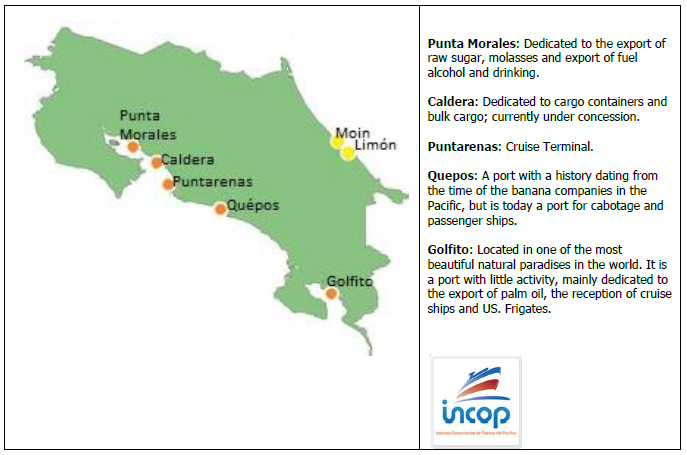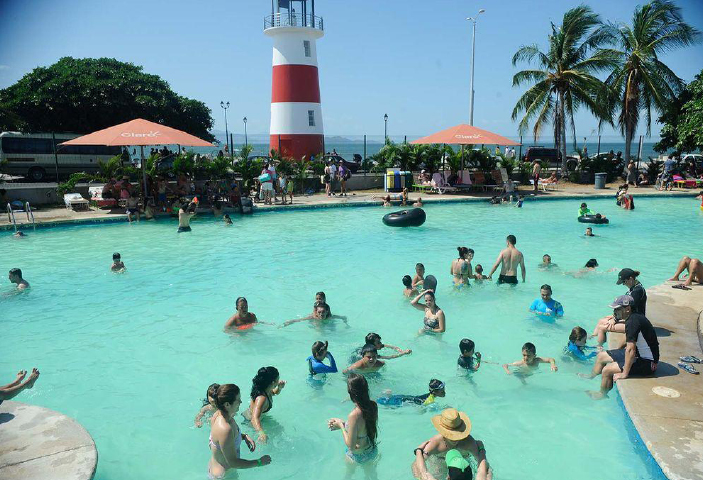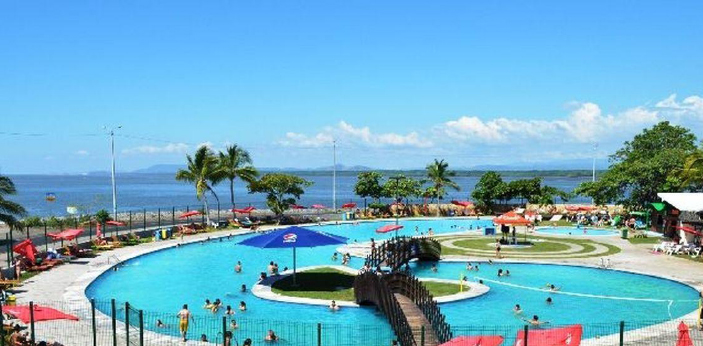The Costa Rican Institute of Pacific Ports (called in Spanish as INCOP), recently enrolled to RETE, is an autonomous institution that manages five ports of Costa Rica, and also has the mission to strengthen, with works of interest, the development of the port city of Puntarenas and other cities located on the same coast.
This is achieved by Law No. 8461, which establishes the use of the resources generated by the busiest port Caldera, that presents a concession contract, to finance maintenance projects, infrastructure construction, decoration, cleaning and public safety, with emphasis in tourism, through the legal figure of a financial trust with a state bank and the participation of the Ministry of Tourism. In addition, a decentralized unit is created for this purpose called the Tourism Promotion Board.
The five ports of Costa Rica that manages the Costa Rican Institute of Pacific Ports (called in Spanish as INCOP).
Puntarenas and Caldera port
As a brief historical reference, it is indicated that the city of Puntarenas had the main port of the country during the nineteenth century, facilitating the export of tobacco to Guatemala and import of goods from South America (Chile, Peru and Panama) and from Europe. This made a point of great movement of cargo ships, as well as residents, visitors, and of course, commercial activities, giving it a very particular character.
Since 1950, with the construction of the Inter-American highway that connected this city with the rest of the country, it became the main national tourist destination, mainly for residents of the capital San Jose.
Due to population growth and port congestion around the city of Puntarenas in the late sixties, in the seventies the port activities moved to the present site, known as Caldera. The pier and buildings left in Puntarenas are intended to serve cruise attention, and as spaces for urban use.
Today visitors to the city of Puntarenas can find fragments of republican and neocolonial architecture, as well as structures that reflect periods of economic impoverishment, along with some public buildings of modern type. However, in the diversity of the urban fabric, the imprint that marked the maritime and port activity defines its character as a port city.
Many of the works created with the resources of the trust contract aim to improve the quality of urban life.
In this sense, one of the most visible projects has been the revitalization of the waterfront, locally known as “Paseo de los Turistas”, which, by its appeal, highlights a work of recent construction, “the Lighthouse”.
The Paseo de los Turistas, one of the projects of the waterfront revitalization.
The Lighthouse is a fundamental element of port heritage that must be protected and preserved. It is a place full of history element, rooted in the collective memory, which can become a focus of cultural regeneration, especially in Costa Rica that is weak in a port maritime culture.
It is striking the iconic character that has acquired this structure in Puntarenas. Every day, but especially at weekends, hundreds of people take selfies with the Lighthouse, which shows that it is a structure that transcends its functional character, to become an object of artistic dimensions and able to give another meaning to the territory.
Nearby to the Lighthouse there is a health resort with swimming pools which for decades has been a reference in the social imaginary of many Costa Ricans. Recently, this site received from INCOP an investment of three million dollars for its revitalization. Most likely those who today are between forty and fifty years of age, regardless of their place of residence or social status, some time in their childhood spent a weekend enjoying the confined waters of this place.
There are many ways to analyze the impact generated by the construction and revitalization of infrastructure in Puntarenas, thanks to given resources from INCOP trust contract or escrow. Personally I would be interested in formulating some hypotheses:
- the first is that the urban image is not in the city but its inhabitants as it is the way citizens represent it in his mind. Therefore, the image identifies the city, not how it is, but as they want to be seen, so that the city makes sense when it is able to satisfy the desire of its inhabitants. As in all desire, it underlies the intention of a fusion, one made between the inhabitant and city. When this desire is satisfied, an event is expressed through a story;
- the second hypothesis is proposing that the image of the city is in a knotting situation between the observer and multiple networks operating in the city, which lead to understanding the cantons of Puntarenas Esparza (contiguous populations) as a communicational tissue with fragments of space and cultural behaviors that creates folds on a dense and irregular structure.
The financial resources promoted by Caldera port, under the figure of trust contract and invested into the region, deserve attention and analysis. That is why in 2017 a Regional Development Plan of the Province of Puntarenas will start, which will allow the INCOP and Tourism Promotion Board a greater assertiveness in their investments, with significant impacts on improving the quality of life in Puntarenas.
Head image: The Lighthouse in Puntarenas, a fundamental element of port heritage.
INCOP: Puerto y ciudad en una Ley
El Instituto Costarricense de Puertos del Pacífico (INCOP), recientemente afiliado a RETE, es una institución autónoma que gestiona cinco puertos de Costa Rica, pero que además tiene como misión fortalecer, con obras de interés turístico, el desarrollo de la ciudad portuaria de Puntarenas, y otras ciudades ubicadas en esta misma vertiente.
Esto se logra mediante la Ley N°8461, que establece el uso de los recursos generados por el puerto con mayor movimiento y que está concesionado, Caldera, para financiar proyectos de mantenimiento, construcción de infraestructura, ornato, limpieza y seguridad ciudadana, con énfasis en actividad turística, mediante la figura legal de fideicomiso, con un banco estatal y la participación del Ministerio de Turismo. Además, se complementa con una unidad desconcentrada creada para estos fines como es la Junta Promotora de Turismo.
Los cinco puertos de Costa Rica que gestiona el Instituto Costarricense de Puertos del Pacífico (INCOP).
Puntarenas y Puerto Caldera
A modo de una breve referencia histórica, vale indicar que la ciudad de Puntarenas albergó el principal puerto del país durante el siglo XIX, facilitando la exportación de tabaco a Guatemala y la importación de bienes de América del Sur (Chile, Perú y Panamá) y de Europa. Esto la convirtió en un punto de gran movimiento de buques de carga, así como de pobladores, visitantes, y por supuesto, de actividades comerciales, imprimiéndole un carácter muy particular.
A partir de 1950, con la construcción de la carretera Interamericana que conectó esta ciudad con el resto del país, se convirtió en el principal destino turístico de nacionales, principalmente de los pobladores de la capital San José.
Debido al crecimiento poblacional y el congestionamiento de buques que se dio alrededor del puerto de Puntarenas a finales de los años sesentas, en la década de los setentas el puerto se trasladó al lugar actual, conocido como Caldera. El muelle y las edificaciones que quedaron en Puntarenas se han destinado al servicio de la atención de cruceros, y como espacios de uso urbano.
Quienes visitan hoy la ciudad de Puntarenas pueden encontrar fragmentos de arquitectura republicana y neocolonial, así como también estructuras que reflejan periodos de empobrecimiento económico, junto con algunos edificios públicos de tipo moderno. Sin embargo, en la diversidad del entramado urbano, se mantiene la huella que marcó la actividad marítima y portuaria y que define su carácter de ciudad puerto.
Muchas de las obras creadas con los recursos del fideicomiso tienen el objetivo de mejorar la calidad de la vida urbana.
En este sentido uno de los proyectos más visibles ha sido la revitalización del frente marítimo (waterfront), conocido localmente como “el Paseo de los Turistas”, en el que destaca, por su atractivo, una obra de reciente construcción, “el Faro”.
El Paseo de los Turistas, uno de los proyectos de revitalización del frente marítimo.
El faro es un elemento fundamental del patrimonio portuario que es necesario proteger y conservar. Es un elemento lleno de historia, arraigado en la memoria colectiva, que puede convertirse en un foco de regeneración cultural, especialmente cuando en Costa Rica es débil la cultura marítimo portuaria.
Resulta impresionante el carácter icónico que ha adquirido esta estructura en Puntarenas, cada día, pero especialmente los fines de semana, cientos de personas hacen autorretratos (selfies) con el faro, lo que demuestra que es una estructura que trasciende su carácter funcional, para convertirse en un objeto de dimensiones artísticas y con capacidad de darle otro sentido al territorio.
Junto al faro hay un balneario que durante décadas fue un referente en el imaginario social de muchos costarricenses. Recientemente este balneario recibió del INCOP una inversión cercana a los tres millones de dólares para su revitalización. Muy probablemente quienes hoy tienen entre cuarenta y cincuenta años de edad, sin importar su lugar de residencia o condición social, alguna vez en su infancia pasaron un fin de semana disfrutando de las aguas confinadas de este lugar.
Existen muchas formas de analizar el impacto que ha generado la construcción y revitalización de infraestructura en Puntarenas, con los recursos del fideicomiso del INCOP. En lo personal me interesaría partir de algunas hipótesis:
- la primera es que la imagen urbana no pertenece a la ciudad sino a sus habitantes, ya que es el modo como los ciudadanos la representan en su mente. Por eso, la imagen identifica a la ciudad, no cómo es, sino como quiere ser vista, de modo que la ciudad adquiere sentido cuando es capaz de satisfacer el deseo de sus habitantes. Como en todo deseo, subyace la intención de una fusión. En este caso, la fusión entre el habitante y la ciudad. Cuando este deseo se satisface, se produce un acontecimiento que se expresa a través de un relato;
- la segunda hipótesis partiría proponiendo que la imagen de la ciudad se constituye ante una situación de anudamiento entre el observador y las múltiples redes que actúan en la ciudad, lo que supone podría llevar a entender los cantones de Puntarenas y Esparza (poblaciones contiguas), como un tejido comunicacional, con fragmentos de espacio y de comportamientos que crea pliegues culturales sobre una estructura densa e irregular.
Los recursos financieros que salen del puerto de Caldera, bajo la figura del fideicomiso y se invierten en la región, merecen atención y análisis. Es por ello que en el año 2017 se iniciará la elaboración del Plan Regional de Desarrollo de la Provincia de Puntarenas, lo que le permitirá al INCOP y a la Junta Promotora de Turismo tener mayor asertividad en sus inversiones, con impactos más significativos en el mejoramiento de la calidad de vida de los puntarenenses.
Head image: El faro en Puntarenas, un elemento fundamental del patrimonio portuario.


